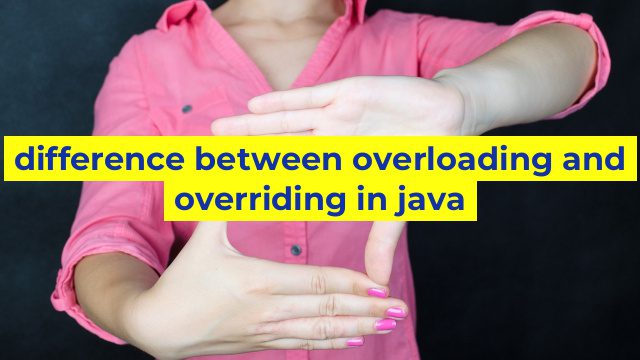The Difference Between Overloading and Overriding in Java
Java is one of the most commonly used programming languages today. It is known for its object-oriented programming concepts, including overloading and overriding. These two concepts are often used interchangeably but they are quite different. Let us understand the difference between Overloading and Overriding in Java.
What is Overloading in Java?
Overloading is a method of defining multiple methods with the same name in Java, but with different parameters. Java allows developers to define methods with the same name but with different parameters, as long as they have a different signature. A method signature is defined by the method’s name and the parameters. For example:
“`
public void myMethod() {} //Method 1
public void myMethod(int x) {} //Method 2
public void myMethod(String y) {} //Method 3
“`
In the above example, `myMethod()` is overloaded with three variations, based on the parameter types. Depending on the argument passed, the appropriate version of the method is called.
What is Overriding in Java?
Overriding is a way of providing a different implementation for the same method declared by the parent class or interface in the child class. In other words, it involves creating a new implementation of an existing method signature in a child class.
For example:
“`
public interface Animal {
void eat();
}
public class Lion implements Animal{
@Override
public void eat() {
System.out.println(“Lion is eating meat”);
}
}
“`
In the above example, the `Animal` interface declares the method `eat()`. In the `Lion` class which implements the `Animal` interface, the `eat()` method is overridden. The method is implemented differently than the default implementation provided by the interface.
Key Differences Between Overloading and Overriding in Java
The key differences between Overloading and Overriding in Java can be summarized as follows:
1. Overloading occurs within the same class, while overriding occurs between a subclass and a superclass.
2. Overloading is achieved by changing the number or types of parameters, while Overriding requires an existing method of the superclass.
3. Overloading is used when we want to define multiple methods with the same name, but with different parameters. Overriding is used when we want to change the implementation of a method that is already defined in a parent class or interface.
4. Overloaded methods can have different return types, while Overridden methods must have the same return type as the method that they are overriding.
In conclusion, Overloading and Overriding are both important concepts in Java that help developers write cleaner and more organized code. Knowing the difference between them is crucial, especially for developers who are just starting out in the world of Java programming.
Table difference between overloading and overriding in java
| Feature | Overloading | Overriding |
|---|---|---|
| Definition | Having multiple methods with the same name but different parameters in the same class. | Creating a method in a subclass that has the same name and signature as a method in the superclass. |
| Usage | Used to provide methods with the same name but different functionality or argument types. | Used to change the behavior of a method in a subclass that is already defined in the superclass. |
| Method signature | Different methods have the same name but different argument types or number of arguments. | Method signature must be the same as the method being overridden, including argument types and number of arguments. |
| Return type | Return type may or may not be the same as the original method. | Return type must be the same as the original method. |
| Behavior | Different methods behave differently depending on the arguments passed to them. | The overridden method in the subclass behaves differently than the original method in the superclass. |
